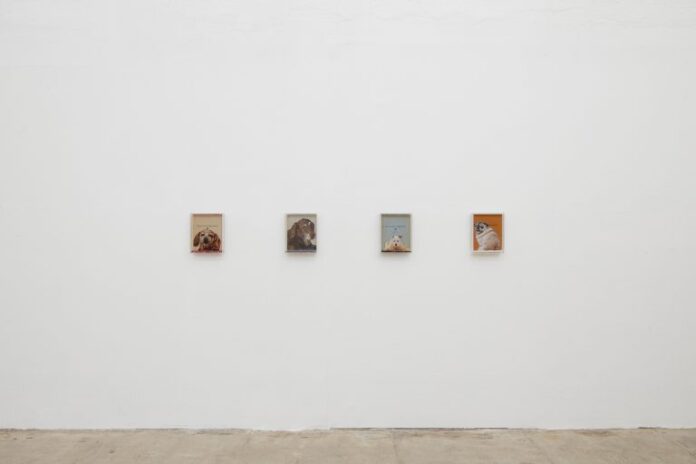“How can one give an account of an irreducible depth of sensibility except by acts that betray it?”
—Pierre Klossowski, Sade My Neighbor
Klossowski’s assertion speaks to the paradox of representation—that to convey the depth of experience, we must distort it. Images cannot fully encapsulate the experiences they represent. Instead, they betray their origins through negotiations of material and process-based intervention. This betrayal is not a failure, but an opening—a necessary fracture. In the works of Christopher Baliwas, Mark Verabioff, and Erin Calla Watson, the unstable fictions that attempt to collate or constrain our lives are pushed beyond the brink. Successive ruptures create inroads into a realm of renewed possibility.
Baliwas’ practice examines the image’s corpus by employing what he calls ‘anti-archival’ methods. Using materials such as packing tape and adhesive, he deconstructs photographic prints, pulling apart layers to create spectral transfers that are subsequently effectuated into a multi-focal archive. By deconstructing and subsequently re-stabilizing the image, his works transform photographs, like Catherine Opie’s depiction of Drake and his son, into distinct, cogent forms.
Gramsci states, “The starting point of critical elaboration is the consciousness of what one really is, and is knowing oneself as a product of the historical process to date, which has deposited in you an infinity of traces, without leaving an inventory.”1 In many esoteric traditions, a tulpa is an autonomous, constructed thought-form, brought into existence through concentrated and consistent mental effort across a long period of time. Baliwas’s use of Drake as a tulpa—a palimpsest of personal, cultural, and colonial histories—exemplifies the critical elaboration suggested by Gramsci. Drake, with dual roles as ‘cultural totem figure’ and ‘disarticulated referent’, exemplifies the infinity of traces, and allows us to confront the blurred boundaries between public personas, private selves, and the collective cultural imaginary. This engagement mirrors the archival process itself—one that is as much about reinvention as it is about retrieval. Baliwas’ exhibited works, suspended on a flagpole or elevated on a transparent shelf, require viewers to shift perspectives, and ask us what we pay—spatially, temporally, or emotionally—in order to “see”. How often are these acts of so-called seeing merely conjectural interactions with unstable, imperfect captures? How much do we actually want to know?
Verabioff’s exhibiting work PUBLIC RELATIONS | SECRET SERVICE (2024), a diptych of two triangle-shaped canvases is composed of materials such as page tears, acrylic, canvas, rubberized undercoating, spray paint, and aluminum tape. The top triangle features a photograph of synth musician Gregory Cameron, taken by the artist in 1982 during his time at the Nova Scotia College of Art and Design. The bottom triangle incorporates a decoupage of another photograph from the same period, sourced from Verabioff’s self-published 2022 zine, BOOFMAGA. This amalgamation of imagery and materials underscores Verabioff’s layered approach to visual storytelling and language-games. The extenuating elements—such as a long, pooling rubber rope emanating from the composition—introduce both humor and discomfort, while amplifying the tactile immediacy of the work. The triangular form, with its connotations of hierarchy and directional movement, becomes a site of visual tension where beginnings and endings collapse into circuitous gestures.
Verabioff’s diptych triangulates history, humor, and critique, to stage what he describes as “visual combat.” Rather than treating the archival as a static repository, Verabioff positions it as a contested space where acts of subsumption generate narratives that resist closure or simplistic identitarian frameworks. Through the juxtaposition of personal and cultural archives, PUBLIC RELATIONS | SECRET SERVICE blurs the boundaries between preservation and transformation, inviting viewers to consider how memory, identity, and cultural production operate in a state of perpetual renegotiation. Verabioff’s work asserts recontextualization as an act of insurgent reclamation, challenging audiences to engage with the unstable, overlapping layers of meaning embedded in his compositions.
Calla Watson’s 2019 wall-based tetraptych, Spiritual America, confines Hugh Hefner’s original 1962 text The Playboy Philosophy underneath printed images sourced from Garry Gross’s 2013 Beautiful Old Dogs. The work’s title alludes to the infamous photograph of a nude, prepubescent Brooke Shields taken by Garry Gross in 1975, which was later appropriated by Richard Prince in 1983. Watson’s use of Gross’s imagery—this time of elderly dogs—creates an uneasy juxtaposition that interrogates how aesthetics of innocence, exploitation, and sentimentality are mediated through culture. By placing these frames within a context that nods to commercial consumerism and gendered notions of decoration, Watson critiques the commodification of identity and its intersections with patriarchal and capitalist structures.
The front chambers of the plexiglass boxes are filled with oil and glitter, allowing a double-utility as working snow globes, and alluding to commercially available snowglobe picture frames. When shaken, the glitter momentarily obscures the layers beneath, introducing a shimmering veil that disrupts direct perception. The upright orientation of the tetraptych echoes the verticality Nietzsche and Klossowski associate with human meaning-making, while the physical act of shaking the boxes—a disruption of this upright state—produces provisional, apprehensive chaos. As the glitter gradually settles, the work stages a metaphorical process of reinterpretation through settling the unsettled. The suturing of Hefner’s philosophy and Gross’s images introduces complex cultural codes of exploitation and a dissonant nostalgia. Nietzsche’s insight into the falsification inherent in consciousness—its tendency to impose its own criteria for meaning—resonates as the viewer’s perception shifts between text, image, and snow globe.
Encountering these works together, one must make an inventory for what is seen and what remains unseen. As a Drake IG caption implores, “What is most important for you right now is to connect to your own inner light.”
—Jasminne Morataya
at Ehrlich Steinberg, Los Angeles
until February 8, 2025

